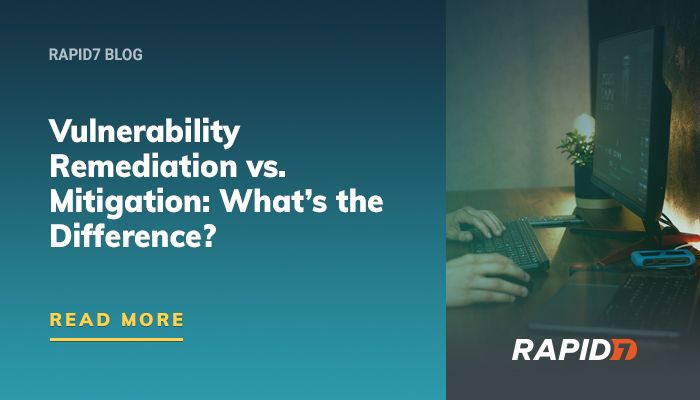Remediated vs Mitigated: Understanding the Key Differences

Introduction
When it comes to dealing with issues or risks, the terms “remediated” and “mitigated” are often used interchangeably. However, these words hold unique meanings and implications. Understanding the key differences between them is crucial in various scenarios, be it environmental cleanup, cybersecurity, project management, or risk assessment. In this in-depth article, we explore and elucidate the nuances of “remediated vs mitigated” to equip you with valuable insights and knowledge. So, let’s dive right in!
Remediated vs Mitigated: Unraveling the Definitions
Before we delve deeper into the divergences, let’s establish a clear understanding of what “remediated” and “mitigated” mean individually.
1. Remediated: Addressing the Root Cause
When a problem is remediated, it means that the underlying issue or root cause has been thoroughly identified and addressed. Remediation efforts aim to eliminate the problem at its source, preventing its recurrence and any potential adverse consequences. This term is often associated with environmental cleanup, where contaminated sites are remediated to restore their natural state, safeguarding ecosystems and public health.
2. Mitigated: Reducing the Impact
On the other hand, mitigation focuses on reducing the impact of a problem without necessarily eliminating its root cause. Instead of targeting the source directly, mitigation strategies aim to lessen the consequences or severity of the issue. This approach is commonly employed in risk management, where steps are taken to reduce the impact of potential hazards or threats.
The Nuances of “Remediated vs Mitigated” in Different Contexts
The application of these terms varies based on the context in which they are used. Let’s explore how “remediated” and “mitigated” play out in various scenarios:
3. Environmental Cleanup: Restoring Nature’s Balance
- Remediated: Reviving Contaminated Sites In the realm of environmental science, “remediated” refers to the comprehensive restoration of contaminated sites to their original, uncontaminated state. Remediation processes involve rigorous assessments, site characterization, and the implementation of remedial action plans to ensure the complete elimination of pollutants.
Example: The former industrial site was successfully remediated through a combination of soil excavation, bioremediation, and groundwater treatment, enabling the site’s transformation into a lush green space.
- Mitigated: Managing Environmental Impact While remediation focuses on complete restoration, mitigation concentrates on managing the impact of pollution or human activities on the environment. Mitigation measures aim to minimize ecological damage while allowing certain human activities to continue responsibly.
Example: To mitigate the environmental impact of a new road construction project, wildlife corridors were established, enabling the safe passage of animals through the area.
4. Cybersecurity: Tackling Digital Threats
- Remediated: Eradicating Cyber Threats In the realm of cybersecurity, “remediated” indicates the successful elimination of digital threats, such as malware, viruses, or cyberattacks. Remediation efforts involve identifying the breach, patching vulnerabilities, and restoring affected systems to their pre-attack state.
Example: The cybersecurity team quickly identified and remediated the ransomware attack, restoring access to encrypted files and enhancing the organization’s defenses against future incidents.
- Mitigated: Reducing Cyber Risks Mitigation in the cybersecurity context refers to proactive measures taken to reduce the likelihood or impact of potential threats. This may include implementing firewalls, data encryption, and security awareness training for employees.
Example: The company’s proactive approach to cybersecurity mitigation significantly reduced the risk of data breaches and unauthorized access to sensitive information.
5. Project Management: Navigating Challenges
- Remediated: Overcoming Project Issues In project management, “remediated” denotes the successful resolution of critical issues that could hinder project progress. Remediation efforts involve identifying the root cause of delays or roadblocks and taking decisive actions to get the project back on track.
Example: Through effective stakeholder communication and resource reallocation, the project manager remediated the delays caused by unforeseen supply chain disruptions.

Understanding the Key Differences - Mitigated: Managing Project Risks Mitigation in project management focuses on anticipating potential risks and developing proactive strategies to manage or lessen their impact on project timelines and deliverables.
Example: By implementing contingency plans and diversifying suppliers, the project team effectively mitigated the risks associated with volatile market conditions.
Addressing Common FAQs
FAQ 1: Are “Remediated” and “Mitigated” the Same Thing?
No, “remediated” and “mitigated” are not interchangeable terms. While both involve addressing problems or risks, “remediated” implies eliminating the root cause, whereas “mitigated” refers to reducing the impact without necessarily eliminating the source.
FAQ 2: Can Remediation and Mitigation Be Used Together?
Absolutely! In many cases, remediation and mitigation go hand in hand. Combining these approaches can create a more robust and comprehensive solution to tackle complex issues effectively.
FAQ 3: Is Remediation Always More Expensive Than Mitigation?
The cost of remediation versus mitigation depends on various factors, such as the nature of the issue, the scale of impact, and the chosen approach. In some instances, remediation may be costlier due to the extensive measures required to address the root cause.
FAQ 4: How Does Remediation Benefit the Environment?
Remediation plays a crucial role in restoring contaminated sites, protecting natural habitats, and ensuring the well-being of ecosystems. By eliminating pollutants and hazardous substances, remediation contributes to a healthier environment for both humans and wildlife.
FAQ 5: Can Mitigation Alone Provide a Permanent Solution?
While mitigation can reduce the impact of an issue, it may not provide a permanent solution if the root cause remains unaddressed. In certain situations, remediation may be necessary to achieve long-lasting results.
FAQ 6: Which Approach Is Best for Risk Management?
The choice between remediation and mitigation in risk management depends on the specific risk and its potential consequences. For severe and immediate threats, remediation might be more suitable, while mitigation can be effective for managing foreseeable risks.
Conclusion
In conclusion, “remediated vs mitigated” are two distinct approaches to dealing with issues and risks. Remediation aims to eliminate the root cause, while mitigation focuses on reducing the impact. The choice between these approaches depends on the context and the desired outcomes. Whether it’s environmental cleanup, cybersecurity, or project management, understanding the differences between remediation and mitigation empowers individuals and organizations to make informed decisions and create sustainable solutions.







